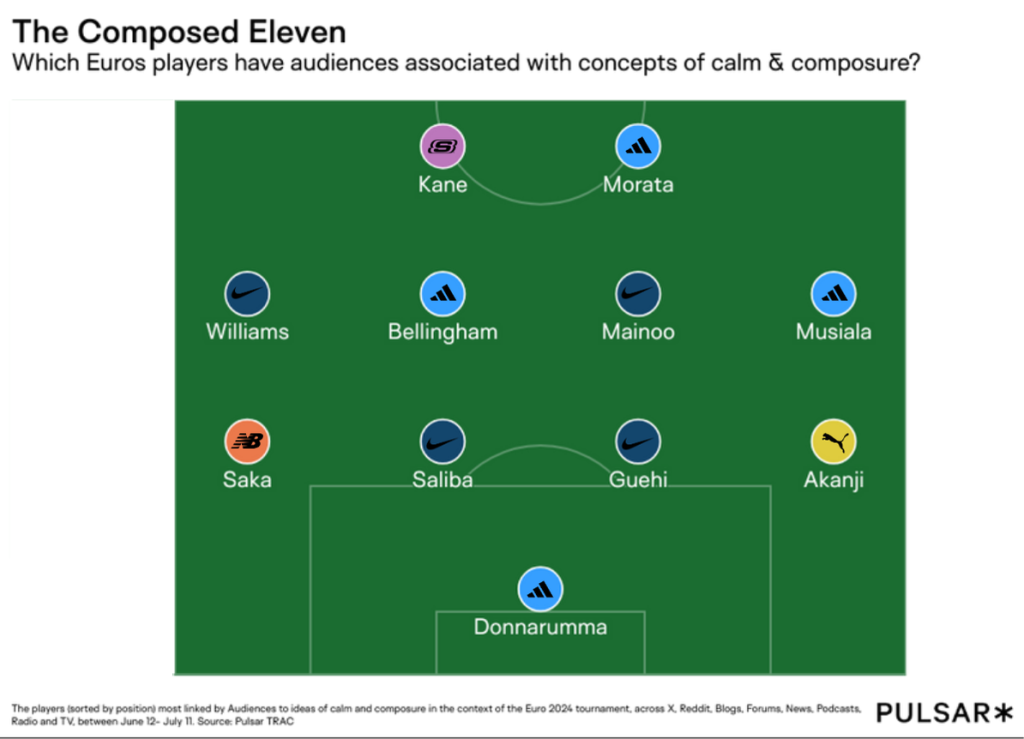
Nike vs Adidas: two different Euros campaigns, two different audiences
- Sport
The Euro 2024 final sees a showdown between two of the continent’s sporting superpowers. Not England and Spain, but rather the brands adorning their respective kits: Nike and Adidas. Rather counterintuitively, it’s Spain who’ll have three lines on their shirt.
The Euros is one of the world’s most popular sporting events, attracting global audiences in their hundreds of millions. And for brands such as Nike and Adidas, who are embedded into the tournament’s fabric and history to an unparalleled extent, it provides an opportunity to reach those global audiences with aspirational narratives they’re invited to identify with, and insert themselves into.
So what messaging did each brand adopt for its Euros campaign?
Nike have historically focused on defying limits and breaking down the sense of what's possible - this has been heightened into the feverish mood of their most recent ad campaign: Awaken Your Madness.
There’s something special that separates those at the top from everyone else. @Vinijr @KMbappe @erlinghaaland @10Ronaldinho
𝑨𝒘𝒂𝒌𝒆𝒏 𝒀𝒐𝒖𝒓 𝑴𝒂𝒅𝒏𝒆𝒔𝒔.
#NikeFootball pic.twitter.com/mms7adk8w6— Nike Football (@nikefootball) June 13, 2024
The campaign speaks to the ‘crazy’ side of being an elite sportsperson - when the straining for excellence goes beyond what might be considered reasonable.
Conversely Adidas’ campaign strikes a very different chord: retaining composure, calm and nonchalance under enormous - sometimes unimaginable - pressure.
It's only the weight of the nation.
You Got This. pic.twitter.com/CcjWC1ctG3
— adidas alerts (@adidasalerts) June 4, 2024
Using Pulsar TRAC, we can explore why these decisions may have been made - and the audiences they engage for each brand.
First, Adidas. Exploring the social and media conversation around the Euros, we can see that it’s common for posters and journalists alike to refer to players being composed and capable of dealing with pressure.
In fact, we can map out a full team of the players most commonly described as such.

Identifying the right players to sign-up as ambassadors is a key aspect of sports marketing campaigns. Each athlete brings their own devoted audiences, and also helps accentuate particular aspects of the brand’s identity.
To that extent Adidas have been stymied by Nike matching them player for calme and composed player. A closer look at the numbers tells a more positive story for the German brand, however. Jude Bellingham, the undoubted star of this year’s Adidas campaign (and his own advert) is the player most referred to in this way by audiences and the media.
This suggests a neat symbiosis between the message Adidas have put out, the way in which audiences celebrate modern footballers, and the athletes the brand has signed - even if a deeper German run might have seen Kroos, Gundogan et al creep into the 11.
For Nike, it’s a different story.
Simply put, there is no comparable conversation around being dedicated to the point of obsession. Such mentions as there are to being crazy or obsessive are more likely to refer to easily avoidable yellow cards or a winger’s wholehearted dedication to running down the same blind alley time after time.
But Nike’s campaign was nonetheless a good one - and the reason can be found when we compare the audiences of the two brands.
Here, we’ve compared the international audiences who follow either Adidas or Nike, and display a strong affinity for football.
The first thing we notice is that the Nike fans are far more likely to be American than their Adidas equivalent. They are also far more likely to be gamers.
It’s important that the Nike audience is more American - and more exposed to American sports - because the subject and tone of the Nike campaign - Unleash Your Madness - has more precedent within US sporting culture.
Weird how Michael Jordan was a competitive psychopath who had a maniacal intensity & beat down his own teammates til they played to his standards. Racking my brain trying to think if that reminds me of anyone pic.twitter.com/C0F4C6gaMX
— SCOUTWITHBRYAN (@ScoutWithBryan) May 11, 2020
This was hugely amplified in recent years by the success of Netflix’s The Last Dance, which brought stories of Jordan’s immense commitment and competitiveness to a far broader, global audience.
European sporting culture has, of course, produced athletes in the vein of Cristiano Ronaldo and Novak Djokovic in recent years, both of whom are famed for their singularly dedicated pursuit of success, but the idea that this might be defined as a kind of productive ‘madness’ is less culturally embedded within Europe.
Beyond simple demographic data, it’s also notable that a greater contingent of the Nike/Football audience show affinity for online gaming.
There is an avalanche of online content which centers on esports and livestreaming games. And a common refrain within this conversation is the linguistic framing of players, games and moments as ‘crazy’, a ‘madness’ or otherwise.
I PROMISE this is the most insane 8 seconds of EAFC you will see this weekend 😂
You will have to watch this back a few times to take in all the madness in the clip 🤦
Side note...I won 4-3 in ET 😂🤢 pic.twitter.com/ZkHqQnjIQH
— Alexion (@AlexionIQ) November 11, 2023
As such, both brands reflect different elements of the prevailing Football discourse. Adidas appears to more closely reflect the language of Euros-watchers, while Nike taps more into the cultural currents running alongside modern football, from its growing closeness with US sports culture to the popularity of gaming and esports as engines for fandom.
To stay up to date with our latest insights and releases, sign up to our newsletter below:


